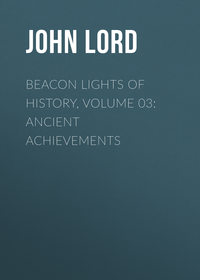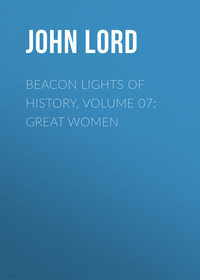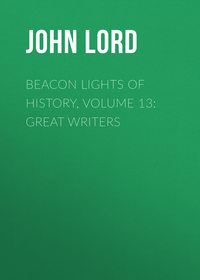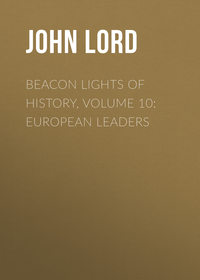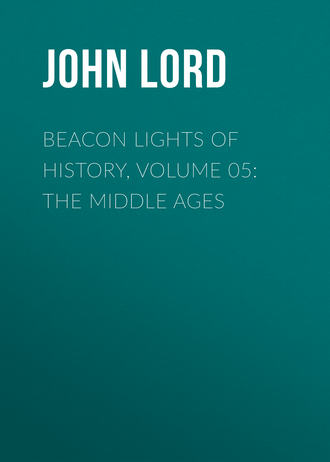 полная версия
полная версияBeacon Lights of History, Volume 05: The Middle Ages
About the time this book appeared the works of Aristotle were introduced to the attention of students, translated into Latin from the Saracenic language. Aristotle had already been commented upon by Arabian scholars in Spain,–among whom Averroes, a physician and mathematician of Cordova, was the most distinguished,–who regarded the Greek philosopher as the founder of scientific knowledge. His works were translated from the Greek into the Arabic in the early part of the ninth century.
The introduction of Aristotle led to an extension of philosophical studies. From the time of Charlemagne only grammar and elementary logic and dogmatic theology had been taught, but Abélard introduced dialectics into theology. A more complete method was required than that which the existing schools furnished, and this was supplied by the dialectics of Aristotle. He became, therefore, at the close of the twelfth century, an acknowledged authority, and his method was adopted to support the dogmas of the Church.
Meanwhile the press of students at Paris, collected into various schools,–the chief of which were the theological school of Notre Dame, and the school of logic at Mount Geneviève, where Abélard had lectured,–demanded a new organization. The teachers and pupils of these schools then formed a corporation called a university (Universitas Magistrorum et Scholarium), under the control of the chancellor and chapter of Notre Dame, whose corporate existence was secured from Innocent III. a few years afterwards.
Thus arose the University of Paris at the close of the twelfth century, or about the beginning of the thirteenth, soon followed in different parts of Europe by other universities, the most distinguished of which were those of Oxford, Bologna, Padua, and Salamanca. But that of Paris took the lead, this city being the intellectual centre of Europe even at that early day. Thither flocked young men from Germany, England, and Italy, as well as from all parts of France, to the number of twenty-five or thirty thousand. These students were a motley crowd: some of them were half-starved youth, with tattered clothes, living in garrets and unhealthy cells; others again were rich and noble,–but all were eager for knowledge. They came to Paris as pilgrims flocked to Jerusalem, being drawn by the fame of the lecturers. The old sleepy schools of the convents were deserted, for who would go to Fulda or York or Citeaux, when such men as Abélard, Albert, and Victor were dazzling enthusiastic youth by their brilliant disputations? These young men also seem to have been noisy, turbulent, and dissipated for the most part, "filling the streets with their brawls and the taverns with the fumes of liquor. There was no such thing as discipline among them. They yelled and shouted and brandished daggers, fought the townspeople, and were free with their knocks and blows." They were not all youth; many of them were men in middle life, with wives and children. At that time no one finished his education at twenty-one; some remained scholars until the age of thirty-five.
Some of these students came to study medicine, others law, but more theology and philosophy. The headquarters of theology was the Sorbonne, opened in 1253,–a college founded by Robert Sorbon, chaplain of the king, whose aim was to bring together the students and professors, heretofore scattered throughout the city. The students of this college, which formed a part of the university, under the rule of the chancellor of Notre Dame, it would seem were more orderly and studious than the other students. They arose at five, assisted at Mass at six, studied till ten,–the dinner hour; from dinner till five they studied or attended lectures; then went to supper,–the principal meal; after which they discussed problems till nine or ten, when they went to bed. The students were divided into hospites and socii, the latter of whom carried on the administration. The lectures were given in a large hall, in the middle of which was the chair of the master or doctor, while immediately below him sat his assistant, the bachelor, who was going through his training for a professorship. The chair of theology was the most coveted honor of the university, and was reached only by a long course of study and searching examinations, to which no one could aspire but the most learned and gifted of the doctors. The students sat around on benches, or on the straw. There were no writing-desks. The teaching was oral, principally by questions and answers. Neither the master nor the bachelor used a book. No reading was allowed. The students rarely took notes or wrote in short-hand; they listened to the lectures and wrote them down afterwards, so far as their memory served them. The usual text-book was the "Book of Sentences," by Peter Lombard. The bachelor, after having previously studied ten years, was obliged to go through a three years' drill, and then submit to a public examination in presence of the whole university before he was thought fit to teach. He could not then receive his master's badge until he had successfully maintained a public disputation on some thesis proposed; and even then he stood no chance of being elevated to a professor's chair unless he had lectured for some time with great éclat Even Albertus Magnus, fresh with the laurels of Cologne, was compelled to go through a three years' course as a sub-teacher at Paris before he received his doctor's cap, and to lecture for some years more as master before his transcendent abilities were rewarded with a professorship. The dean of the faculty of theology was chosen by the suffrages of the doctors.
The Organum (philosophy of first principles) of Aristotle was first publicly taught in 1215. This was certainly in advance of the seven liberal arts which were studied in the old Cathedral schools,–grammar, rhetoric, and dialectic (Trivium); and arithmetic, geometry, music, and astronomy (Quadrivium),–for only the elements of these were taught. But philosophy and theology, under the teaching of the Scholastic doctors (Doctores Scholastici), taxed severely the intellectual powers. When they introduced dialectics to support theology a more severe method was required. "The method consisted in connecting the doctrine to be expounded with a commentary on some work chosen for the purpose. The contents were divided and subdivided, until the several propositions of which it was composed were reached. Then these were interpreted, questions were raised in reference to them, and the grounds of affirming or denying were presented. Then the decision was announced, and in case this was affirmative, the grounds of the negative were confuted."
Aristotle was made use of in order to reduce to scientific form a body of dogmatic teachings, or to introduce a logical arrangement. Platonism, embraced by the early Fathers, was a collection of abstractions and theories, but was deficient in method. It did not furnish the weapons to assail heresy with effect. But Aristotle was logical and precise and passionless. He examined the nature of language, and was clear and accurate in his definitions. His logic was studied with the sole view of learning to use polemical weapons. For this end the syllogism was introduced, which descends from the universal to the particular, by deduction,–connecting the general with the special by means of a middle term which is common to both. This mode of reasoning is opposite to the method by induction, which rises to the universal from a comparison of the single and particular, or, as applied in science, from a collection and collation of facts sufficient to form a certainty or high probability. A sound special deduction can be arrived at only by logical inference from true and certain general principles.
This is what Anselm essayed to do; but the Schoolmen who succeeded Abélard often drew dialectical inferences from what appeared to be true, while some of them were so sophistical as to argue from false premises. This syllogistic reasoning, in the hands of an acute dialectician, was very efficient in overthrowing an antagonist, or turning his position into absurdity, but not favorable for the discovery of truth, since it aimed no higher than the establishment of the particulars which were included in the doctrine assumed or deduced from it. It was reasoning in perpetual circles; it was full of quibbles and sophistries; it was ingenious, subtle, acute, very attractive to the minds of that age, and inexhaustible from divisions and subdivisions and endless ramifications. It made the contests of the schools a dialectical display of remarkable powers in which great interest was felt, yet but little knowledge was acquired. In one respect the Scholastic doctors rendered a service: they demolished all dreamy theories and poured contempt on mystical phrases. They insisted, like Socrates, on a definite meaning to words. If they were hair-splitting in their definitions and distinctions, they were at least clear and precise. Their method was scientific. Such terms and expressions as are frequently used by our modern transcendental philosophers would have been laughed to scorn by the Schoolmen. No system of philosophy can be built up when words have no definite meaning. This Socrates was the first to inculcate, and Aristotle followed in his steps.
With the Crusades arose a new spirit, which gave an impulse to philosophy as well as to art and enterprise. "The primum mobile of the new system was Motion, in distinction from the Rest which marked the old monastic retreats." An immense enthusiasm for knowledge had been kindled by Abélard, which was further intensified by the Scholastic doctors of the thirteenth century, especially such of them as belonged to the Dominican and Franciscan friars.
These celebrated Orders arose at a great crisis in the Papal history, when rival popes aspired to the throne of Saint Peter, when the Church was rent with divisions, when princes were contending for the right of investiture, and when heretical opinions were defended by men of genius. At this crisis a great Pope was called to the government of the Church,–Innocent III., under whose able rule the papal power culminated. He belonged to an illustrious Roman family, and received an unusual education, being versed in theology, philosophy, and canon law. His name was Lothario, of the family of the Conti; he was nephew of a pope, and counted three cardinals among his relatives. At the age of twenty-one, about the year 1181, he was one of the canons of Saint Peter's Church; at twenty-four he was sent by the Pope on important missions. In 1188 he was created cardinal by his uncle, Clement III.; and in 1198 he was elected Pope, at the age of thirty-eight, when the Crusades were at their height, when the south of France was agitated by the opinions of the Albigenses, and the provinces on the Rhine by those of the Waldenses. It was a turbulent age, full of tumults, insurrections, wars, and theological dissensions. The old Benedictine monks had lost their influence, and were disgraced by idleness and gluttony, while the secular clergy were ignorant and worldly. Innocent cast his eagle eye into all the abuses which disgraced the age and Church, and made fearless war upon those princes who usurped his prerogatives. He excommunicated princes, humbled the Emperor of Germany and the King of England, put kingdoms under interdict, exempted abbots from the jurisdiction of bishops, punished heretics, formed crusades, laid down new canons, regulated taxes, and directed all ecclesiastical movements. His activity was ceaseless, and his ambition was boundless. He instituted important changes, and added new orders of monks to the Church. It was this Pope who instituted auricular confession, and laid the foundation of a more dreadful spiritual despotism in the form of inquisitions.
Yet while he ruled tyrannically, his private life was above reproach. His habits were simple and his tastes were cultivated. He was charitable and kind to the poor and unfortunate. He spent his enormous revenues in building churches, endowing hospitals, and rewarding learned men; and otherwise showed himself the friend of scholars, and the patron of benevolent movements. He was a reformer of abuses, publishing the most severe acts against venality, and deciding quarrels on principles of justice. He had no dramatic conflicts like Hildebrand, for his authority was established. As the supreme guardian of the interests of the Church he seldom made demands which he had not the power to enforce. John of England attempted resistance, but was compelled to submit. Innocent even gave the archbishopric of Canterbury to one of his cardinals, Stephen Langton, against the wishes of a Norman king. He took away the wife of Philip Augustus; he nominated an emperor to the throne of Constantine; he compelled France to make war on England, and incited the barons to rebellion against John. Ten years' civil war in Germany was the fruit of his astute policy, and the only great failure of his administration was that he could not exempt Italy from the dominion of the Emperors of Germany, thus giving rise to the two great political parties of the thirteenth and fourteenth centuries,–the Guelphs and Ghibellines.
To cement his vast spiritual power he encouraged what doubtless seemed even to him a great fanaticism, but which he found could be turned to his advantage,–that of the Mendicant Friars, established by Saint Francis of Assisi, and Saint Dominic of the great family of the Guzmans in Spain. These men made substantially the same offers to the Pope that Ignatius Loyola did in after times,–to go where they were sent as teachers, preachers, and missionaries without condition or reward. They renounced riches, professed absolute poverty, and wandered from village to city barefooted, and subsisting entirely on alms as beggars. The Dominican friar in his black habit, and the Franciscan in his gray, became the ablest and most effective preachers of the thirteenth century. The Dominicans confined their teachings to the upper classes, and became their favorite confessors. They were the most learned men of the thirteenth century, and also the most reproachless in morals. The Franciscans were itinerary preachers to the common people, and created among them the same religious revival that the Methodists did later in England under the guidance of Wesley. The founder of the Franciscans was a man who seemed to be "inebriated with love," so unquenchable was his charity, rapt his devotions, and supernal his sympathy. He found his way to Rome in the year 1215, and in twenty-two years after his death there were nine thousand religious houses of his Order. In a century from his death the friars numbered one hundred and fifty thousand. The increase of the Dominicans was not so rapid, but more illustrious men belonged to this institution. It is affirmed that it produced seventy cardinals, four hundred and sixty bishops, and four popes.
It was in the palmy days of these celebrated monks, before corruption had set in, that the Dominican Order was recruited with one of the most extraordinary men of the Middle Ages. This man was Saint Thomas, born 1225 or 1227, son of a Count of Aquino in the kingdom of Naples, known in history as Thomas Aquinas, "the most successful organizer of knowledge," says Archbishop Trench, "the world has known since Aristotle." He was called "the angelical doctor," exciting the enthusiasm of his age for his learning and piety and genius alike. He was a prodigy and a marvel of dialectical skill, and Catholic writers have exhausted language to find expressions for their admiration. Their Lives of him are an unbounded panegyric for the sweetness of his temper, his wonderful self-control, his lofty devotion to study, his indifference to praises and rewards, his spiritual devotion, his loyalty to the Church, his marvellous acuteness of intellect, his industry, and his unparalleled logical victories. When he was five years of age his father, a noble of very high rank, sent him to Monte Cassino with the hope that he would become a Benedictine monk, and ultimately abbot of that famous monastery, with the control of its vast revenues and patronage. Here he remained seven years, until the convent was taken and sacked by the soldiers of the Emperor Frederic in his war with the Pope. The young Aquino returned to his father's castle, and was then sent to Naples to be educated at the university, living in a Benedictine abbey, and not in lodgings like other students. The Dominicans and Franciscans held chairs in the university, one of which was filled with a man of great ability, whose preaching and teaching had such great influence on the youthful Thomas that he resolved to join the Order, and at the age of seventeen became a Dominican friar, to the disappointment of his family. His mother Theodora went to Naples to extricate him from the hands of the Dominicans, who secretly hurried him off to Rome and immured him in their convent, from which he was rescued by violence. But the youth persisted in his intentions against the most passionate entreaties of his mother, made his escape, and was carried back to Naples. The Pope, at the solicitation of his family, offered to make him Abbot of Monte Cassino, but he remained a poor Dominican. His superior, seeing his remarkable talents, sent him to Cologne to attend the lectures of Albertus Magnus, then the most able expounder of the Scholastic Philosophy, and the oracle of the universities, who continued his lectures after he was made a bishop, and even until he was eighty-five. When Albertus was transferred from Cologne to Paris, where the Dominicans held two chairs of theology, Thomas followed him, and soon after was made bachelor. Again was Albert sent back to Cologne, and Thomas was made his assistant professor. He at once attracted attention, was ordained priest, and became as famous for his sermons as for his lectures. After four years at Cologne Thomas was ordered back to Paris, travelling on foot, and begging his way, yet stopping to preach in the large cities. He was still magister and Albert professor, but had greatly distinguished himself by his lectures.
His appearance at this time was marked. His body was tall and massive, but spare and lean from fasting and labor. His eyes were bright, but their expression was most modest. His face was oblong, his complexion sallow; his forehead depressed, his head large, his person erect.
His first great work was a commentary of about twelve hundred pages on the "Book of Sentences," in the Parma edition, which was received with great admiration for its logical precision, and its opposition to the rationalistic tendencies of the times. In it are discussed all the great theological questions treated by Saint Augustine,–God, Christ, the Holy Spirit, grace, predestination, faith, free-will, Providence, and the like,–blended with metaphysical discussions on the soul, the existence of evil, the nature of angels, and other subjects which interested the Middle Ages. Such was his fame and dialectical skill that he was taken away from his teachings and sent to Rome to defend his Order and the cause of orthodoxy against the slanders of William of Saint Amour, an aristocratic doctor, who hated the Mendicant Friars and their wandering and begging habits. William had written a book called "Perils," in which he exposed the dangers to be apprehended from the new order of monks, in which he proved himself a true prophet, for ultimately the Mendicant Friars became subjects of ridicule and reproach. But the Pope came to the rescue of his best supporters.
On the return of Thomas to Paris he was made doctor of theology, at the same time with Bonaventura the Franciscan, called "the seraphic doctor," between whom and Thomas were intimate ties of friendship. He had now reached the highest honor that the university could bestow, which was conferred with such extraordinary ceremony that it would seem to have been a great event in Paris at that time.
His fame chiefly rests on the ablest treatise written in the Middle Ages,–the "Summa Theologica,"–in which all the great questions in theology and philosophy are minutely discussed, in the most exhaustive manner. He took the side of the Realists, his object being to uphold Saint Augustine. He was more a Platonist in his spirit than an Aristotelian, although he was indebted to Aristotle for his method. He appealed to both reason and authority. He presented the Christian religion in a scientific form. His book is an assimilation of all that is precious in the thinking of the Church. If he learned many things at Paris, Cologne, and Naples, he was also educated by Chrysostom, by Augustine, and Ambrose. "It is impossible," says Cardinal Newman, and no authority is higher than his, "to read the Catena of Saint Thomas without being struck by the masterly skill with which he put it together. A learning of the highest kind,–not mere literary book knowledge which may have supplied the place of indexes and tables in ages destitute of these helps, and when they had to be read in unarranged and fragmentary manuscripts, but a thorough acquaintance with the whole range of ecclesiastical antiquity, so as to be able to bring the substance of all that had been written on any point to bear upon the text which involved it,–a familiarity with the style of each writer so as to compress in a few words the pith of the whole page, and a power of clear and orderly arrangement in this mass of knowledge, are qualities which make this Catena nearly perfect as an interpretation of Patristic literature." Dr. Vaughan, in eulogistic language, says: "The 'Summa Theologica' may be likened to one of the great cathedrals of the Middle Ages, infinite in detail but massive in the grouping of pillars and arches, forming a complete unity that must have taxed the brain of the architect to its greatest extent. But greater as work of intellect is this digest of all theological richness for one thousand years, in which the thread of discourse is never lost sight of, but winds through a labyrinth of important discussions and digressions, all bearing on the fundamental truths which Paul declared and Augustine systematized."
This treatise would seem to be a thesaurus of both Patristic and Mediaeval learning; not a dictionary of knowledge, but a system of truth severely elaborated in every part,–a work to be studied by the Mediaeval students as Calvin's "Institutes" were by the scholars of the Reformation, and not far different in its scope and end; for the Patristic, the Mediaeval, and the Protestant divines did not materially differ in reference to the fundamental truths pertaining to God, the Incarnation, and Redemption. The Catholic and Protestant divines differ chiefly on the ideas pertaining to government and ecclesiastical institutions, and the various inventions of the Middle Ages to uphold the authority of the Church, not on dogmas strictly theological. A student in theology could even in our times sit at the feet of Thomas Aquinas, as he could at the feet of Augustine or Calvin; except that in the theology which Thomas Aquinas commented upon there is a cumbrous method, borrowed from Aristotle, which introduced infinite distinctions and questions and definitions and deductions and ramifications which have no charm to men who have other things to occupy their minds than Scholastic subtilties, acute and logical as they may be. Thomas Aquinas was raised to combat, with the weapons most esteemed in his day, the various forms of Rationalism, Pantheism, and Mysticism which then existed, and were included in the Nominalism of his antagonists. And as long as universities are centres of inquiry the same errors, under other names, will have to be combated, but probably not with the same methods which marked the teachings of the "angelical doctor." In demolishing errors and systematizing truth he was the greatest benefactor to the cause of "orthodoxy" that appeared in Europe for several centuries, admired for his genius as much as Spencer and other great lights of science are in our day, but standing preeminent and lofty over all, like a beacon light to give both guidance and warning to inquiring minds in every part of Christendom. Nor could popes and sovereigns render too great honor to such a prodigy of genius. They offered him the abbacy of Monte Cassino and the archbishopric of Naples, but he preferred the life of a quiet student, finding in knowledge and study, for their own sake, the highest reward, and pursuing his labors without the impedimenta of those high positions which involve ceremonies and cares and pomps, yet which most ambitious men love better than freedom, placidity, and intellectual repose. He lived not in a palace, as he might have lived, surrounded with flatterers, luxuries, and dignities, but in a cell, wearing his simple black gown, and walking barefooted wherever he went, begging his daily bread according to the rules of his Order. His black gown was not an academic badge, but the Dominican dress. His only badge of distinction was the doctors' cap.




